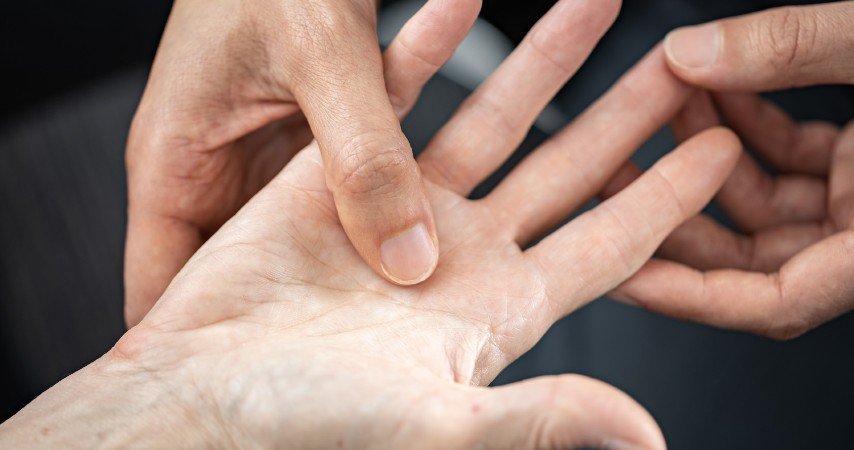
Dupuytren’s Contracture is a condition that affects the fascia, the deep layer of tissue in the palm of the hand. It causes nodules and cords to form beneath the skin, which can pull the fingers into a bent position.
Over time, this contracture prevents the fingers from straightening fully, limiting hand function and making everyday tasks more difficult.
Dupuytren’s Contracture often develops slowly and may not cause pain, but it can affect how the hand moves and functions over time. Early signs can be subtle, so it’s important to be aware of the common symptoms:
The exact cause of the condition is not fully understood, but research shows that it can be influenced by both genetic and environmental factors and most often appears between the ages of 50 and 60.
Treatment of Dupuytren’s disease depends on the severity of symptoms. Once finger contractures have developed and the hand cannot be placed flat on a table, surgery is indicated to restore hand function. In mild cases, the tight cords may be able to be released using a needle passed through the skin. In more severe cases, the tight cords may need to be excised through incisions in the palm.
Diagnosis of Dupuytren’s Contracture is usually made during a clinical examination of the hand. Treatment depends on the severity of the condition. In mild cases, tight cords may be released with a needle passed through the skin, while in more advanced cases, surgery may be required to remove the cords through small incisions in the palm. Surgery is often recommended once contractures develop to the point where the hand can no longer be placed flat on a table.
Recovery and aftercare vary depending on the procedure performed. It is common to experience some swelling, stiffness or discomfort in the hand during the early stages, and gentle finger movement is usually encouraged to support healing. Hand therapy may be recommended to improve strength and flexibility, while stitches are generally removed within one to two weeks.
Most people return to light activities within a few weeks, with gradual improvement continuing over several months. Regular follow-up appointments are an important part of aftercare to ensure your recovery is progressing as expected.
A consultation with your plastic surgeon will enable personalisation of the procedure and care to your unique situation.
Surgery is usually performed as day surgery under either general anaesthetic or local anaesthetic and sedation. You will need to fast on the day of surgery, and organise a support person to take you home and be around to help in the first few days after surgery.
A post-operative appointment will be organised for you to see your plastic surgeon 1-2 weeks after surgery to check your wounds, remove sutures and provide advice to care for your hand as you recover. Generally you will not be able to drive for 2-3 weeks after surgery and will need between 2-4 weeks off work depending on your type of work (manual work vs office based work).
All operations have risks, though major complications are rare after Dupuytrens surgery. There is a small risk of concerns that may delay healing and require a little extra care (eg minor bleeding, infection, or over active or sensitive scars). Very rarely there is a risk of injury to the digital nerves which provide sensation to the fingers. Rarely there is a risk of recurrence of dupuytrens disease over many years.
These risks may vary depending on your specific situation and will be discussed with you at your consultation. Please feel reassured that your plastic surgeon will only recommend surgery if they feel that the benefit of the procedure substantially outweigh the risks.
If you have Dupuytren’s disease, the majority of the cost is rebatable through Medicare and standard private health insurance. This does require a referral from your family doctor.
After your consultation, a detailed quote will be provided to you including the surgeon fee, anaesthetic fee and hospital fee.
Dupuytren’s Contracture is usually not painful, especially in the early stages. Most people notice firm lumps or cords in the palm and gradual bending of the fingers, but without significant discomfort. In some cases, tenderness may occur where nodules develop, but pain is not a common feature of the condition.
There is no evidence that exercises can stop Dupuytren’s Contracture from progressing, but gentle hand and finger stretches may help maintain mobility and comfort. After treatment, exercises prescribed by your doctor are often recommended to restore strength, flexibility, and function. Your surgeon or therapist will provide guidance on the most appropriate exercises for your recovery.
You can use this form to request a call back.
Please be aware that all surgical procedures require a consultation with our plastic surgeons to allow a thorough assessment and discussion of your specific needs.








Plastic Surgery Central
235 Greenhill Rd
Dulwich SA 5065